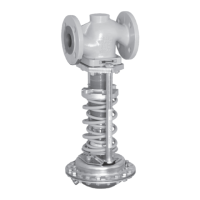42 EB 2517 EN
Servicing
7.4 Replacing the operating
diaphragm
Risk of regulator damage due to excessively
high or low tightening torques.
Observe the specied torques on tightening
regulator components. Excessively tightened
torques lead to parts wearing out quicker.
Parts that are too loose may cause leakage.
Observe the specied tightening torques.
SAMSON's After-sales Service department
can support you concerning lubricant,
tightening torques and tools approved by
SAMSON.
The associated order number is written on
the actual operating diaphragm.
Î RefertoFig.3
Removing the operating diaphragm
1. Put the regulator out of operation (see
section9.1).
2. Unscrew the control line (17).
3. Unscrew the nuts (9) and remove the ac-
tuator.
4. Clamp the actuator stem (11) into a suit-
ablexture.Markthesideoftheactua-
tor to avoid reassembling it the wrong
way.
NOTICE
!
Note
Tip
5. Unscrew nuts and bolts (15) from the ac-
tuator. Remove the actuator case with
control line connection (16).
6. Unscrew the diaphragm plate nut (14)
and remove the operating diaphragm
(12) from the diaphragm plate (13).
Mounting the operating diaphragm
1. Place the operating diaphragm (12) onto
the diaphragm plate (13) and tighten the
diaphragm plate nut (14). Observe the
tighteningtorquesspeciedinsec-
tion7.5.
2. Place on the actuator case with control
line connection (16). Check the correct
position of the control line connection
nipple (marking).
3. Insert nuts and bolts (15) and tighten
gradually in a crisscross pattern. Ob-
servethetighteningtorquesspeciedin
section7.5.
4. Push the actuator onto the spigots of the
actuator bellows (5.1). Tighten the nuts
(9). Observe the tightening torques spec-
iedinsection7.5.
5. Screw on the control line (17). Observe
thetighteningtorquesspeciedinsec-
tion7.5.
6. Put the regulator into operation (see sec-
tion6.1).

